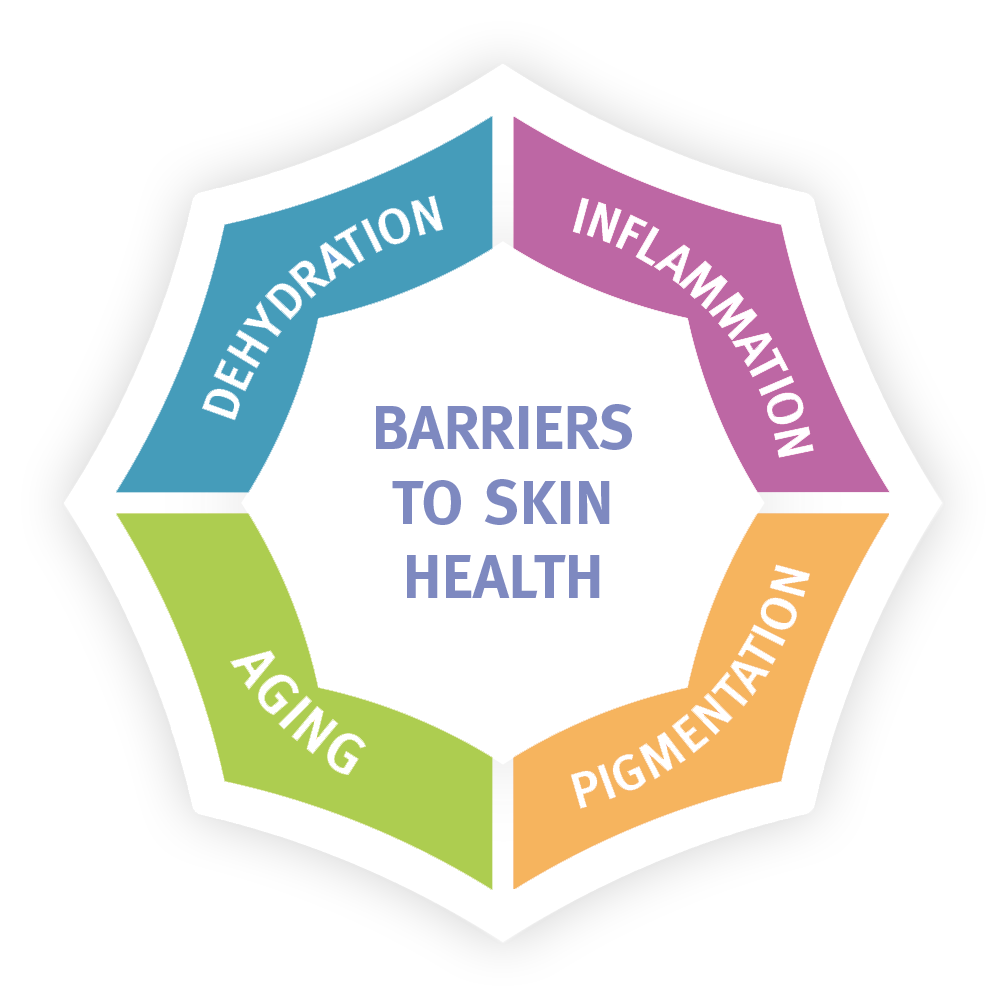What Are the Four Barriers to Skin Health?


Previous skin typing systems classified skin types into dry, oily, combination, or normal. However, there are many shortcomings to this type of classification system, including the fact that the barriers to skin health are not considered. The Baumann Skin Typing System, developed in 2004 by Dr. Leslie Baumann, instead classifies your skin type based on which of the four barriers to skin health your skin has: inflammation, dehydration, pigmentation, and aging.
While some Baumann Skin Types have just one barrier to skin health, others may have all four. The goal is to use skincare products that will eliminate these 4 issues. Taking a validated scientific quiz found at SkinTypeSoluitons.com will help you identify which of these 4 barriers to skin health that your skin has. Don’t guess!! Many studies such as this one show that people are often wrong about their skin type.
Learn more about each of the barriers here, as well as what you can do to help reverse them.
1. Inflammation
Eight of the 16 Baumann Skin Types have underlying inflammation. Inflammation occurs when inflammatory factors within your body cause blood vessels to dilate, resulting in red flushing of the skin. Skin types that exhibit sensitivity are more likely to have activation of various inflammatory pathways. These pathways involve substances and cell structures such as arachidonic acid, toll-like receptors, bradykinin, cytokines, interleukins, and many others. Once these pathways are turned on, it is very difficult to turn them back off. Other cells in your body begin to produce more inflammatory factors, creating a chain reaction. As a result of inflammation, blood vessels dilate and may become leaky, causing redness and flushing. Inflammation is also the underlying cause of a wide array of skin problems, including acne, eczema, and rosacea.
Inflammation can be caused by a number of factors, including the immune system, friction, chemicals, very low or very high pH, bacteria, fungi, and more.
Anti-inflammatory ingredients such as argan oil, green tea, niacinamide, and resveratrol can help to combat inflammation, redness, and other symptoms. If you struggle with inflammatory conditions like acne or rosacea, talk to your doctor about the most appropriate treatment products for these specific concerns.
2. Dehydration
Dry skin has trouble holding onto moisture and easily becomes dehydrated. This occurs as a result of an impaired skin barrier. A healthy barrier contains a 1:1:1 ratio of fatty acids, ceramides, and cholesterol to seal moisture inside and keep irritants out. In dry skin types, however, this ratio is thrown off and the skin barrier is unable to function properly. This allows for moisture to escape into the atmosphere and irritants and debris to penetrate the skin.
The good news is that dry skin types can improve their skin fairly easily by using the correct skincare products. Choose creamy non-foaming cleansers, barrier repair moisturizers such as Zerafite, and gentle oils like argan oil to help your skin maintain proper hydration and improve its barrier function.
Barrier repair moisturizers use MLE technology to mimic the skin’s natural lipid structure located in the outermost layer in order to strengthen barrier function and eliminate dryness, itching, and flaking.
3. Pigmentation
Pigmented skin types struggle with dark spots on the skin, as well as conditions like melasma and post-inflammatory hyperpigmentation. Overactive melanocytes – the cells that create the pigment melanin – cause too much pigment to be produced, resulting in uneven skin tone and dark spots. While some people are genetically predisposed to overactive melanocytes, external factors like sun exposure also play a significant role in pigmentation issues. In fact, “age spots” aren’t caused by aging at all, but rather years of accumulated unprotected exposure to the sun.
Thus, the first line of defense against this barrier to skin health is sunscreen. Everyone – including those with naturally dark skin tones – should wear at least SPF 15 on a daily basis and higher SPF when outside.
Pigmented skin types can also use skin lightening ingredients like vitamin C, hydroquinone, kojic acid, and retinoids to achieve a more even skin tone. I recommend that you take a one-month break from these products every three to four months to avoid side effects such as redness, dryness, and rare pigmentation complications.
4. Aging
Your skin is at an increased risk of developing signs of aging if you are over the age of 30 or have lifestyle habits that increase aging. These include not wearing sunscreen, eating a high-sugar diet, lack of sleep, overuse of drugs and alcohol, and others.
Aging skin produces less collagen, elastin, hyaluronic acid, and heparan sulfate and is therefore prone to wrinkles, creases, sagging, and dehydration. To reverse these effects, use anti-aging ingredients that are appropriate for your Baumann Skin Type, such as antioxidants, retinoids, growth factors, and heparan sulfate, and always wear sunscreen.
What is the Ideal Skin Type?
Baumann Skin Type number 10, ORNT, is considered the ideal skin type since it has no barriers to skin health. It should be your goal to change your skin type the perfect skin type ORNT.
How to Find Your Baumann Skin Type®
Not sure what your Baumann Skin Type is and which of these barriers you may be dealing with? Download the Skin Type Solutions mobile app or go to SkinTypeSoluitons.com to take the quick and easy questionnaire about your skin’s characteristics to determine your Baumann Skin Type. Then, work with an STS-approved physician in your area to create a customized skincare routine designed to improve the specific barriers that keep your skin from reaching its optimal potential.
©2019 Metabeauty, Inc. All images such as the face illustration and barriers to skin health octagon are copyrighted and may not be used without permission.


